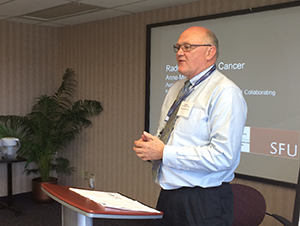Radon in schools: A summary of testing efforts across Canada
CAREX Canada has released a follow-up report investigating the rates of radon testing in Canadian schools.
Radon gas is the leading cause of lung cancer among non-smokers and is responsible for approximately 16% of lung cancer deaths in Canada.[1,2] Radon is colourless and odourless, so testing is the only way to know if radon levels are elevated and if remediation is required. Many organizations are working to assess radon exposure in homes and raise awareness about the importance of testing. Given that children and staff spend a considerable amount of time indoors in schools – where radon levels can accumulate to high levels – the CAREX Canada team has prioritized radon exposure in Canadian schools.
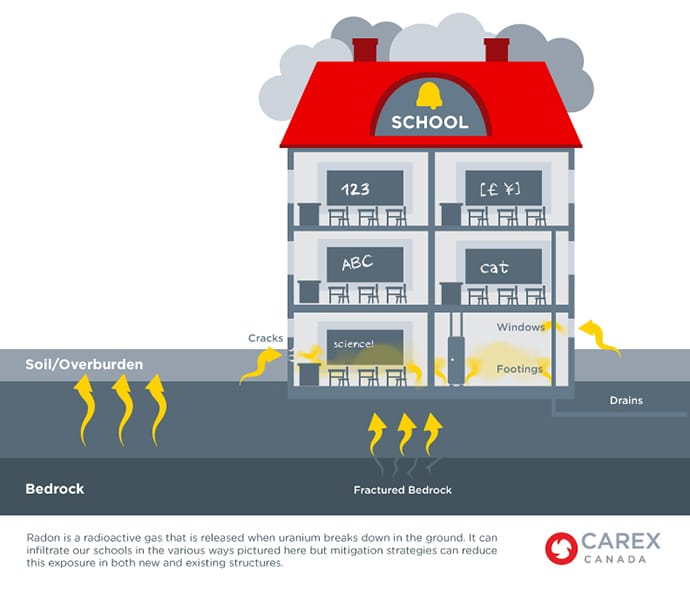
Led by Associate Professor Anne-Marie Nicol, CAREX revisited its investigation of radon testing efforts in schools across Canada. Staff contacted ministries of Health and Education, and the Offices of the Chief Medical Officer in each province and territory. Subsequently, staff also contacted individual school boards’ Superintendents or Chairs in an effort to determine where school testing has occurred, if schools with elevated levels were remediated, and what challenges were encountered in testing or remediating.
Key findings from this investigation include:
- All public schools in Saskatchewan, New Brunswick, Nova Scotia, Prince Edward Island, and Yukon have been tested for radon.
- British Columbia, Alberta, Manitoba, Ontario, and Newfoundland have low rates of radon testing in schools.
- Quebec has a collaborative approach to radon testing in schools led by the ministries of Education and Health, which is a product of the Inter-sectoral Committee on Radon.
- Over 500 schools across the country expressed interest or developed plans to test for radon in 2018.
- In some provinces, new schools are built to facilitate remediation should they report elevated levels of radon.
- Some school buildings, such as those in some regions in the Northwest Territories and Nunavut, are constructed above ground on piles and therefore, may not require radon testing.[3]
- Only Prince Edward Island and Yukon make all school testing results openly available to the public.
A more detailed summary for each province and territory is provided at the bottom of this page. Our publication on the results of this research is available here.
UPDATE: Following the release of this report in 2017, a number of Canadian schools have tested for radon. As of November 2018, 106 additional schools have tested for radon in BC, including six school districts (92 schools) where testing was supported by Vancouver Coastal Health. An additional 50 schools in Alberta are being tested in fall 2018/winter 2019. In Manitoba, 10 additional schools have tested for radon, where test kits were provided free from the Manitoba School Board Association.
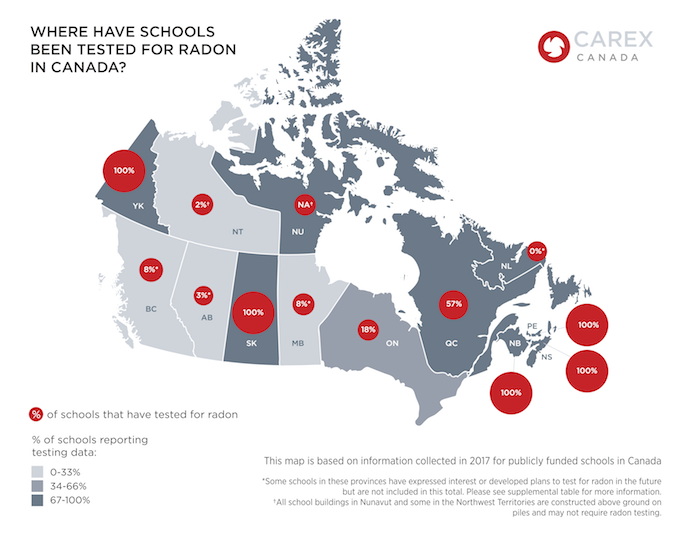
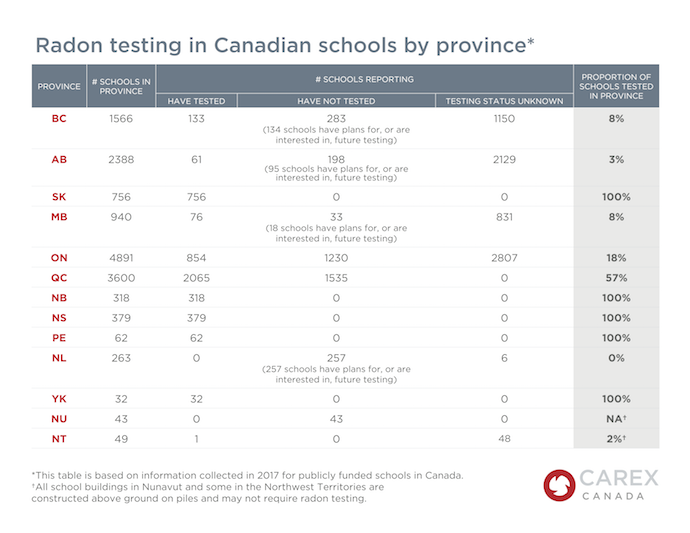
Why does radon exposure matter? CAREX Canada has a carcinogen profile on radon, available here. Radon is a radioactive gas released when uranium, found naturally in rocks and soil, decays. This gas emits radioactive particles that can attach to the surface of aerosols, dust, and smoke and are easily inhaled into the lungs, causing damage to DNA that can develop into cancer.[4] CAREX Canada risk estimates for indoor air carcinogens show that radon gas is the highest priority exposure in Canadian settings.[5] The gas can enter and accumulate in buildings through unfinished floors, wall slab joints, sump pumps, windows, and cracks and openings in foundations.[6] The US EPA estimates that one in five schools in the US have elevated radon levels.[7]
What is being done about this exposure? As part of their Cross-Canada Survey of Radon Concentrations in Homes, Health Canada has tested many dwellings across the country. The results of this survey are visualized in maps available on the CAREX Canada website..[8,9] These maps illustrate how some provinces have higher overall levels than others. In order to minimize health risks, Health Canada recommends that all buildings, including homes and schools, be tested and remediated to ensure they have less than 200 becquerels per cubic metre (Bq/m3) of radon gas.[10] Health Canada also recently released an updated guide to school testing.[11]
Without a national school testing mandate however, provinces approach the issue of radon testing in unique ways. In some provinces and territories, the agencies responsible for testing in schools include ministries of Health, Education, Infrastructure, Transportation, and Labour. Where there is no provincial government involvement, school districts assume the responsibility of testing and remediation. These programs are often assisted and supported by external organizations, such as school board associations, health authorities, and teachers’ unions.
Due to changes in building codes across Canada, newly constructed government buildings, including schools, are designed and built with a radon mitigation “rough-in” system that can be activated if it is found that radon levels are above Health Canada’s guideline. Even with a radon mitigation “rough-in” system, schools still need to be tested for elevated levels of radon. Radon testing in schools continues to increase, and CAREX staff found that over 500 schools across the country expressed interest or developed plans to test for radon in 2018.
For a full list of CAREX resources on radon exposure in workplaces and communities, please visit our Radon Resources page.
British Columbia
As of 2017, British Columbia (BC) still does not have a province-wide program for testing in schools. Schools were identified targets for testing as far back as the 1990s, when research was started in the Interior region. In 2009, WorkSafeBC released the results of this testing in a report titled Radon In British Columbia Work Places. The report states that 17% of schools in the Interior at that time reported levels above 150 Bq/m3. Schools with elevated levels were either remediated or closed for reasons other than radon levels.
CAREX staff contacted all 60 public school districts in BC to obtain a more accurate understanding of current testing efforts. We found that 133 (8%) public schools have been tested for radon, and 283 (18%) public schools have not. Data were unreported or unknown for 45 school districts, which account for 1,150 (73%) public schools. Most school districts that reported radon testing in schools had levels below 200 Bq/m3. In schools that reported levels over 200 Bq/m3, remediation was either completed or is underway.
A number of districts asked us how they could initiate testing. Seven school districts, totalling 134 public schools, reported they would be interest in, or are planning to begin testing in 2018.
UPDATE: As of November 2018, 106 additional schools have tested for radon in BC, including six school districts (92 schools) where testing was supported by Vancouver Coastal Health.
Alberta
As of 2015, as a result of changes to the 2014 Alberta Building Code (ABC), a radon mitigation rough-in system must be installed in any newly constructed public building. Alberta Infrastructure developed an internal mandate for all new Government of Alberta Owned and Supported buildings to be designed and built to follow the ABC. These government buildings include schools, school board buildings, healthcare boards, municipalities, post-secondary facilities, and other public-sector organizations.
Additionally, Alberta Infrastructure developed a technical specification for rough-in systems for radon mitigation. When a new building is completed, the building owner is responsible for bringing in a certified C-NRPP professional to determine the radon levels in the building. If results are above the Health Canada guideline, building owners must activate the radon ventilation system. This program was initiated due to Health Canada’s and Alberta Health’s recommendation to test all publicly occupied buildings for radon.
CAREX staff contacted all 85 public school boards in Alberta to investigate radon testing efforts. Only 61 (3%) schools reported testing for radon, and 198 (8%) confirmed that radon testing has not been done. Ninety-five schools reported they would be interest in, or are planning to begin testing in 2018. Radon testing efforts are unknown or unreported for 2,129 of the 2,388 schools in Alberta.
Occasionally, Alberta Infrastructure’s Building Environment Unit supports remediation efforts by providing technical specification documents and connecting school boards to certified C-NRPP technicians and third-party organizations for remediation options. Ongoing efforts include updates to the program based on changes and advancements in radon testing, mitigation technology, and alternative solutions proposed by industry professionals.
UPDATE: As of November 2018, 50 additional schools in Alberta are being tested in fall 2018/winter 2019.
Saskatchewan
Saskatchewan was the first province to create a comprehensive province-wide radon testing initiative in all school buildings. The first survey took place between April and December 1990, testing all schools to assess the need to develop further strategies to reduce radon exposure.
As part of the initial sampling, the Government of Saskatchewan recommended adopting a radon actionable level guideline more closely aligned with the World Health Organization’s radon guidelines of 100 Bq/m3. As a result, the Government of Saskatchewan considered that any school with levels over 112 Bq/m3 is at an elevated risk. Any such school must be retested to measure the true radon level in the building before assessing the need for remediation. The results of the 1990 initiative concluded that 79 of the schools tested had levels of above 112 Bq/m3.
When the Health Canada guideline was modified from 800 Bq/m3 to 200 Bq/m3 in 2007, the Ministry of Education embarked on follow-up testing in all schools. The province was able to remediate and retest all buildings that recorded radon levels above 200 Bq/m3, and once again reduce the overall radon risk in Saskatchewan schools following the Health Canada guideline.
The province’s commitment to minimize radon exposure in schools has led to ample retesting in schools of concern. The Ministry of Education is also conscious of health risks from extended and elevated radon exposure, and builds new schools with ventilation and structural considerations that reduce exposure.
Manitoba
In Manitoba, there is no province-wide radon testing policy or program for public schools. The Manitoba School Boards Association reported that radon testing is at the discretion of individual school boards and that the Association has helped some smaller school boards with testing.
The Manitoba School Boards Association also reported that radon testing began in the province in the early 1990s, when short-term testing was conducted in over half of the schools. This program used 400 Bq/m3 as a reference level and six schools reported elevated results. All six schools were remediated.
Since then, Health Canada lowered the reference level for schools and other public buildings to 200 Bq/m3. In 2010, Manitoba School Boards Association chose 33 schools at random for testing using the updated reference level. Two of these 33 schools reported radon levels above the reference level, and have since been remediated. The Manitoba School Boards Association identified that more recent radon testing of all schools in the province is needed.
CAREX staff also contacted all 39 public school boards in the province. Of these, 76 (8%) schools confirmed testing for radon, and 33 (3%) schools confirmed testing had not been done. Of the schools that reported testing, none were above the Health Canada guideline. Thirty-two school boards, which oversee 831 (88%) public schools, did not provide any data.
UPDATE: As of November 2018, 10 additional schools have tested for radon in Manitoba, where test kits were provided free from the Manitoba School Board Association.
Ontario
Ontario’s Ministry of Education reported that it has no province-wide radon testing policies or programs in place. Any radon testing in schools is at the discretion of Infrastructure Ontario as the crown agent of owners for each building.
Following the Ministry’s direction, CAREX staff contacted all 84 public school boards in the province. Of the schools contacted, 854 (18%) schools reported that they have tested for radon and 1,230 (25%) schools confirmed that they have not tested for radon. Of the schools that had tested, two school boards overseeing 601 schools indicated that they had remediated schools with levels above Health Canada’s guideline. They did not provide the actual number of schools with elevated readings.
Several school boards identified that they have not tested for radon because it is not mandatory but, if required to do so, they would. In 61 school boards, accounting for 2,807 (57%) schools, radon testing was not reported or is unknown.
Quebec
In recent years, Quebec has become a leader in increasing radon testing in schools. Quebec’s school testing program was developed in 2007 through collaborative efforts of the Ministry of Health and Social Services of Quebec (le ministère de la Santé et des Services sociaux du Québec, MSSS) and the Ministry of Education and Higher Education (le ministère de l’Éducation et de l’Enseignement supérieur, MEES). The collaboration was a product of the Inter-sectoral Committee on Radon (Comité Intersectoriel Québécois Sur le Radon, CIQR) created by the MSSS to develop and implement Quebec’s action plan to reduce health consequences from prolonged and elevated radon exposure.
In 2009, the CIQR piloted a testing program in 65 schools. As a result, a province-wide initiative was launched to test all 3,600 public and private education buildings starting in August 2011. Following this initial probe, the MEES strongly recommended that all schools test for radon and report findings. The information was forwarded to the CIQR in July 2014.
Ultimately, the Institut national de santé publique du Québec (INSPQ) gathered all reported radon information and collated the results, with 57% of schools complying with the radon testing recommendation. The INSPQ identified 124 tests that presented radon levels above the Health Canada guideline. Education material on the effects of radon and potential mitigation strategies were sent to all participants. Emphasis was placed on clear communication to inform participants of prior radon efforts and results from radon test measures.
A secondary outcome of this program was an increase in residential radon testing. As well, the MEES recommended that all newly constructed schools or school expansion projects be designed with methods indicated in the province’s Building Code to mitigate underground hazards, such as radon. The MEES is also encouraged to send reminders to school board managers of the remaining schools that did not initially participate in the 2014 provincial testing initiative, to promote future testing efforts.
New Brunswick
Following the initial release of Health Canada’s radon guidelines in 1990, New Brunswick’s Education Facilities and Pupil Transportation Branch tested all schools for radon. When Health Canada lowered its acceptable level of radon guideline from 800 to 200 Bq/m3 in 2007, the province initiated another multi-year program to test all schools and remediate as needed. From 2008 to 2013, the Department of Education and Early Childhood Development and the Department of Health tested 325 sites including schools and district offices. As a result, the former has invested over $3.6 million in radon testing and has remediated 49 schools.
New Brunswick’s Office of the Chief Medical Health Officer states that no provincial legislation or regulation requires radon testing in all schools; however, there is a province-wide radon testing protocol based on Health Canada’s guideline. Schools that were remediated or recorded levels of radon above the guideline are retested annually, as are schools that were recently renovated. Retesting in Fall 2017 and Winter 2018 is planned for 49 mitigated schools. Testing schedules extend to Winter 2021. New Brunswick identified cost as a key challenge in continuing its testing program.
Nova Scotia
Nova Scotia has tested all public schools at least once as part of its provincial radon testing program, and remediated all public schools with levels above the Health Canada guideline. As well, the province conducted follow-up tests after remediation to ensure that radon levels had been lowered.
The Department of Transportation and Infrastructure created new mandatory clauses in the 2010 edition of the Design Requirements Manual. The Manual contains requirements that are common in all provincial building projects, including specifications for Educational Facility Design. Included in Division 31, Earthwork, is 31.21.00 “Off-Gassing Mitigation,” where Clause 31.21.1.0 states: “Where Phase 1 Environmental Assessment indicates a presence of Radon, TPH or other radioactive waste at contaminating levels, or as directed by the Department, provide for design and installation of a vapour extraction system.” Clause 31.21.1.2, states: “Unless recommended by the Phase 1 Environmental Assessment, or directed by the Department, design a vapour extraction system for radon as a passive system with provision for future activation”.
These additions ensure that any new educational facilities require an environmental assessment for the presence of radon, and if elevated levels are present upon completion of construction, remediation efforts are implemented. With the addition of Clause 31.21.1.2 in the Design Requirement Manual, any newly constructed school will be designed with “a vapour extraction system for radon as a passive system with provision for future activation.”
Prince Edward Island
The ministries of Education and Health initiated a program to test for radon in all schools in 2008 in collaboration with C-NRPP experts. The Government of Prince Edward Island (PEI) assumed all costs from the initiative, leaving the school boards no financial burden.
In Phase 1, 56 schools were tested by June 2008. All results and remediation guidelines are publicly available in the Radon Survey at Selected Sites Across Prince Edward Island report. The report identified 11 schools that required remediation.
In 2009, Phase 2 tested all remaining schools, and retested the schools that had been remediated. The results were again made publicly available in the Phase 2 – Radon Survey at Selected Sites Prince Edward Island report. The retesting was done to confirm that remediation had been required in these specific buildings. In Phase 2, three more schools recorded radon levels above the Health Canada guideline. This led the ministries of Health and Education to begin mitigation efforts in all schools that recorded levels above the federal guideline more than once. As a long-term impact of this program, the Government of PEI is now testing and mitigating to reduce radon levels in any new construction of school buildings.
Newfoundland and Labrador
Any concerns about school infrastructure, including radon testing and mitigation, are directed to the province’s Department of Transportation and Work. In this province, 257 (98%) public schools identified that they did not test for radon. Data were unreported or unknown for 2% of public schools. The schools that have not tested for radon indicated that a province-wide radon testing policy or program is needed to meet the Health Canada guideline.
Yukon
The Government of Yukon’s Department of Education initiated radon testing in all schools between 2016 and 2017. It created guidelines to monitor radon levels in public buildings, including schools, regularly. It has also developed guidelines to remediate schools with radon levels above Health Canada’s guideline within the timeframe recommended by the Federal Government of Canada.
Like PEI, the Yukon has made all recorded radon levels in school buildings publicly available online. The current results indicate that three facilities have recorded levels above the Health Canada guideline. The Government of Yukon stated that it is following through with mitigation action in these three schools.
A future consideration for Yukon’s testing program includes radon testing year-round in all schools to ensure accurate readings of annual radon levels, which can then inform any mitigation action.
Nunavut
Nunavut is the only region in Canada where all schools are constructed above ground on stilts or piles that elevate the buildings. These buildings do not require testing because the space and airflow between the underside of the building and the grade below it allow radon to escape into the atmosphere instead of accumulating into the building above. The Government of Nunavut’s Department of Health identified that none of the schools had been tested for radon due to this construction method.
Northwest Territories
The Northwest Territories has some school buildings that are constructed on pile foundations that elevate the buildings off the ground. These buildings, like those in Nunavut, do not require testing because the space and airflow between the underside of the building and the grade below it allow radon to escape into the atmosphere instead of accumulating into the building above.
The Northwest Territories’ Ministry of Infrastructure indicated that schools are tested where concerns about radon have been raised. Ministry records show that one school reported levels above the Health Canada guideline, and this school has since been remediated for radon.
References
Sources
Subscribe to our newsletters
The CAREX Canada team offers two regular newsletters: the biannual e-Bulletin summarizing information on upcoming webinars, new publications, and updates to estimates and tools; and the monthly Carcinogens in the News, a digest of media articles, government reports, and academic literature related to the carcinogens we’ve classified as important for surveillance in Canada. Sign up for one or both of these newsletters below.
CAREX Canada
School of Population and Public Health
University of British Columbia
Vancouver Campus
370A - 2206 East Mall
Vancouver, BC V6T 1Z3
CANADA
As a national organization, our work extends across borders into many Indigenous lands throughout Canada. We gratefully acknowledge that our host institution, the University of British Columbia Point Grey campus, is located on the traditional, ancestral, and unceded territories of the xʷməθkʷəy̓əm (Musqueam) people.



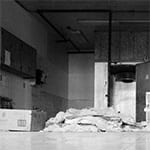


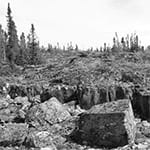


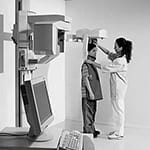 Ionizing radiation:
Ionizing radiation:
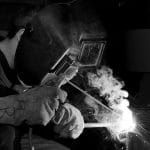
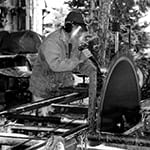
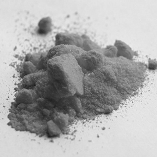 Hexavalent chromium:
Hexavalent chromium: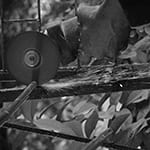 Nickel:
Nickel: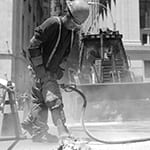 Silica (crystalline):
Silica (crystalline):